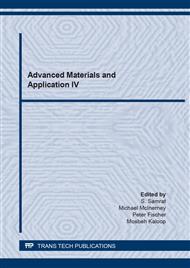[1]
J.F.A. Souto-Maior, A.V. Reis, L.N. Pedreiro, O.A. Cavalcanti, Phosphated crosslinked pectin as a potential excipient for specific drug delivery: Preparation and physicochemical characterization. Polym. Inter. 59 (2010) 127–135.
DOI: 10.1002/pi.2700
Google Scholar
[2]
A. Shalviri, Q. Liu, M.J. Abdekhodaie, X.Y. Wu, Novel modified starch–xanthan gum hydrogels for controlled drug delivery: Synthesis and characterization. Carbohydr. Polym. 79 (2010) 898–907.
DOI: 10.1016/j.carbpol.2009.10.016
Google Scholar
[3]
S. Sasaki, T. Murakami, A. Suzuki, Frictional properties of physically cross-linked PVA hydrogels as artificial cartilage. Biosurf. Biotribol. 2 (2016) 11–17.
DOI: 10.1016/j.bsbt.2016.02.002
Google Scholar
[4]
L. Copeland, J. Blazek, H. Salman, M.C. Tang, Form and functionality of starch. Food Hydrocoll. 23(6) (2009) 1527–1534.
DOI: 10.1016/j.foodhyd.2008.09.016
Google Scholar
[5]
R.P. Ellis, M.P. Cochrane, M.F.B. Dale, C.M. Duffus, A. Lynn, I.M. Morrison, R.D.M. Prentice, J.S. Swanston, S.A. Tiller, Starch production and industrial use. J. Sci. Food Agric. 77(3) (1998) 289–311.
DOI: 10.1002/(sici)1097-0010(199807)77:3<289::aid-jsfa38>3.0.co;2-d
Google Scholar
[6]
J.H. Hun, Chapter 9 - edible films and coatings: a review. Innov. Food Packag. (2nd edi.). (2014): 213–255.
Google Scholar
[7]
S.R. Muppalla, S.R. Kanatt, S.P. Chawla, A. Sharma, Carboxymethyl cellulose – polyvinyl alcohol films with clove oil for active packaging of ground chicken meat. Food Packag. Shelf Life. 2 (2014) 51-58.
DOI: 10.1016/j.fpsl.2014.07.002
Google Scholar
[8]
L. Fan, Y. Du, B. Zhang, J. Yang, J. Zhou, J.F. Kennedy, Preparation and properties of alginate/carboxymethyl chitosan blend fibers. Carbohydr. Polym. 65 (2006) 447–452.
DOI: 10.1016/j.carbpol.2006.01.031
Google Scholar
[9]
J. Li, M. Zhou, G. Cheng, F. Cheng, Y. Lin, P.-X. Zhu, Fabrication and characterization of starch-based nanocomposites reinforced with montmorillonite and cellulose nanofibers. Carbohydr. Polym. 210 (2019) 429–436.
DOI: 10.1016/j.carbpol.2019.01.051
Google Scholar
[10]
T. Siritientong, P. Aramwit, Characteristics of carboxymethyl cellulose/sericin hydrogels and the influence of molecular weight of carboxymethyl cellulose. Macromol. Res. 23(9) (2015) 861–866.
DOI: 10.1007/s13233-015-3116-z
Google Scholar
[11]
S. Ohta, T. Nishiyama, M. Sakoda, K. Machioka, M. Fuke, S. Ichimura, F. Inagaki, A. Shimizu, K. Hasegawa, N. Kokudo, M. Kaneko, Y. Yatomi, T. Ito, Development of carboxymethyl cellulose nonwoven sheet as a novel hemostatic agent. J. Biosci. Bioeng. 119(6) (2015) 718–723.
DOI: 10.1016/j.jbiosc.2014.10.026
Google Scholar
[12]
M. Aoshima, K. Tanabe, I. Kohno, Y. Jo, K. Takahashi, T. Sugo, T, M, Matsuda, Hemostatic mechanisms of a soluble fraction of plant-derived sodium carboymethyl cellulose. J. Throm. Hemost. 23(4) (2012) 387–398.
DOI: 10.2491/jjsth.23.387
Google Scholar
[13]
H. Wang, C. Wang, J. Yao, K. Liu, Study on hemostatic mechanism of fully soluble hemostatic fiber. Blood Coagul. Fibrin. 18(6) (2007) 555–558.
DOI: 10.1097/mbc.0b013e3281eec966
Google Scholar
[14]
W. Tongdeesoontorn, L.J. Mauer, S. Wongruong, P. Sriburi, P. Rachtanapun, Effect of carboxymethyl cellulose concentration on physical properties of biodegradable cassava starch-based films. Chem. Cent. J. 5(1) (2011) 6.
DOI: 10.1186/1752-153x-5-6
Google Scholar
[15]
T.W. Wong, N.A. Ramli, Carboxymethylcellulose film for bacterial wound infection control and healing. Carbohydr. Polym. 112 (2014) 367–375.
DOI: 10.1016/j.carbpol.2014.06.002
Google Scholar
[16]
H.-R. Park, S.-H. Chough, Y.-H. Yun, S.-D. Yoon, Properties of starch/PVA blend films containing citric acid as additive. J. Polym. Environ. 13(4) (2005) 375–382.
DOI: 10.1007/s10924-005-5532-1
Google Scholar
[17]
M.Yıldırım-Yalçın, M. Şeker, H. Sadıkoğlu, Development and characterization of edible films based on modified corn starch and grape juice. Food Chem. 292 (2019) 6–13.
DOI: 10.1016/j.foodchem.2019.04.006
Google Scholar


